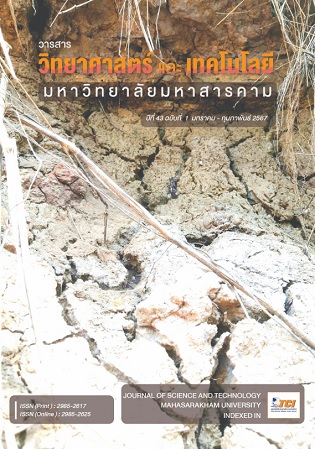Antioxidant activity and phenolic compounds from the fermented sweet corn silk Zea mays L.
Main Article Content
Abstract
Corn silk is classified as agricultural waste. The corn silk has the effect of expelling heat, diuretic, treating nephritis, treating jaundice, nourishing the liver, curing diabetes and treating sinusitis. Numerous health advantages of bioactive substances and antioxidant activity have also been discovered in corn silk. The objectives of this study were prepared by fermentation method to extract bioactive substances from corn silk. Which fermentation can add value to food products. This affects the amount of bioactive substances as well. This study aimed to examine the condition of submerged fermentation as well as the fermented water's functional properties of the fermented water, specifically its antioxidant activity including all phenolic substances. Method for experimenting with fresh sweet corn silk of Hy-brix 10 which fermented by microorganism Lactobacillus casei TISTR 1463 and Saccharomyces cerevisiae TISTR 1464 using stationary fermented in the still state, close with an air lock. The results showed that the fermented sweet corn silk by Lactobacillus casei TISTR 1463 showed the highest of total phenolic compound contents (0.127 mg GAE/mL). Additionally, it has the most total flavonoids content (31.4 mg CE/g of Extract) and the highest antioxidant activity 63.89 %.
Article Details
References
อุทัยทิพย์ ทนเถื่อน, สุดารัตน์ สุวรรณชัย, วีรานันท์ พงศาภักดี และวิโรจน์ กนกศิลปธรรม. (2555). การวิเคราะห์จำนวนนับเซลล์แบคทีเรียจาก Hemacytometer ด้วยวิธีการเชิงสถิติ. วารสารวิทยาศาสตร์และเทคโนโลยี, 20(2), 117-126.
อมร บุญสมบัติ. (2559). ผลของวิธีการคั่วต่อสารออกฤทธิ์ทางชีวภาพในไหมข้าวโพดแห้งเพื่อการผลิตชา [วิทยานิพนธ์ปริญญาวิทยาศาสตร มหาบัณฑิต, มหาวิทยาลัยขอนแก่น]. บัณฑิตวิทยาลัย มหาวิทยาลัยขอนแก่น.
Adetuyi, F. O., & Ibrahim, T. A. (2014). Effect of fermentation time on the phenolic, flavonoid and vitamin C contents and antioxidant activities of okra (Abelmoschus esculentus) seeds. Niger Food Journal, 32, 128–137.
Amadou, I., Yong-Hui, S., Sun, J., & Guo-Wei, L. (2009). Fermented soybean products: Some methods, antioxidants compound extraction and their scavenging activity. Asian Journal of Biochemistry, 4, 68–76.
Bamforth, C. W., & Ward, R. E. (2014). The Oxford handbook of food fermentations. Oxford University Press.
Brand, W.W., Cuvelier, M., & Berset, C. (1995). Use of free radical method to evaluate antioxidant activity. Lebensmittel Wissenschaft und Tech, 28, 25–30.
Bhat, R., Suryanarayana, L. C., Chandrashekara, K. A., Krishnan, P., Kush, A., & Ravikumar, P. (2015). Lactobacillus plantarum mediated fermentation of Psidium guajava L. fruit extract. Journal of Bioscience and Bioengineering, 119, 430–432.
Casarotti, S. N., Borgonovi, T. F., Batista, C. L. F. M., & Penna, A. L. B. (2018). Guava, orange and passion fruit by-products: Characterization and its impacts on kinetics of acidification and properties of probiotic fermented products. Lwt—food Science and Technology, 98, 69–76. https://doi.org/10.1016/j.lwt.2018.08.010
Chisti, Y. (2010). Solid substrate fermentations, enzyme production, food enrichment. In M. C. Flickinger (Ed.), Encyclopedia of industrial biotechnology, bioprocess, bioseparation, and cell technology ( pp. 4516–4534). Wiley.
Ebrahimzadeh, M. A., F. Pourmorad, & S. Hafezi. (2008). Antioxidant activities of Iranian corn silk. Turk. Journal of Biological, 32, 43-49.
Eman, A. A. (2011). Evaluation of antioxidant and antibacterial activities of Egyptian Maydis stigma Zea mays hairs) rich of bioactive constituents. Journal of American Science, 7, 726-729.
Fleet, G.H. (2007). Yeasts in foods and beverages: Impact on product quality and safety. Current Opinion Biotechnol., 18, 170–175.
Hasanudin, K., P. Hashim, & S. Mustafa. (2012). Corn silk (Stigma Maydis) in healthcare: A phytochemical and pharmacological review. Molecules,17, 9697-9715.
Haq, N., Saima, M., Momna, A., &Shakeel A. (2018). Phytochemical Composition: Antioxidant Potential and Biological Activities of Corn. In Amanullah & S. Fahad (eds). Corn - Production and Human Health in Changing Climate. IntechOpen.http://dx.doi.org/ 10.5772/ intechopen.79648
Huynh, N., Van C., John; Smagghe, G., & Raes, K. (2014). Improved release and metabolism of flavonoids by steered fermentation processes: A review. International Journal of Molecular Sciences, 15(11), 19369–19388. doi:10.3390/ijms151119369
Kwak, H. S., Jeong, Y., & Kim, M. (2018). Effect of yeast fermentation of green coffee beans on antioxidant activity and consumer acceptability. Journal of Food Quality, 2018, 5967130.
Loudon, G., & Mark. (2002). Organic chemistry. Oxford University Press.
Martins, S., Mussatto, S.I., Martínez-Avila, G., Montañez-Saenz, J., Aguilar, C.N., &Teixeira, J.A. (2011). Bioactive phenolic compounds: Production and extraction by solid-state fermentation: A review. Biotechnol. Adv., 29, 365–373.
Miller, G., (1959). Use of dinitrisalicylic acid reagent for determination of reducing sugars. Analytical Chemistry, 31, 426-429.
Nakamura, L.K. & Hartman, P.A. (1961): Lactobacillus: yeast interrelationships. Journal of Bacteriology, 81, 519–523
Prommuak, C, De-Eknamkul, W, & Shotipruk, A. (2008). Extraction of flavonoids and carotenoids from Thai silk waste and antioxidant activity of extracts. Sep. Puri. Tech., 62, 444-448.
Salar, R. J., Purewal, S. S., & Bhatti, M.S. (2016).Optimization of extraction conditions and enhancement of phenolic content and antioxidant activity of pearl millet fermented with Aspergillus awamori MTCC-54. Resour. Effic. Technol., 2, 148–157.
Sanjukta, S., Rai, A. K., Muhammed, A., Jeyaram, K. & Talukdar, N. C., (2015), Enhancement of antioxidant properties of two soybean varieties of Sikkim Himalayan region by proteolytic Bacillus subtilis fermentation. Journal of Functional Foods, 14, 650-658.
Sarepoua, E., Tangwongchai, R., Suriharn, B., & Lertrat, K. (2013). Relationships between photochemical and antioxidant activity in corn silk. Int. Food Research Journal, 20, 2073-2079.
Singleton, V.L., Rossi, J.A. (1965) Colorimetry of total phenolics with phos-phomolybdic-phosphotungstic acid reagents. American Journal of Enology and Viticulture, 16,144-158.
Solihah, M. A., Wan Rosil, W. l., & Nurhanan, A.R. (2012). Phytochemicals screening and total phenolic content of Malaysian Zea mays hair extracts. International Food Research Journal, 19, 1533-1538.
Viljoen, B.C. (2006). Yeast ecological interactions. Yeast-yeast, yeast-bacteria, yeast-fungi interactions and yeasts as biocontrol agents. In Querol, A. & Fleet, G. (Eds), The yeast handbook (pp. 83–110). Springer Verlag.
Walter, W., & Purcell, A. E. (1979). Evaluation of several methods for analysis of sweet potato phenolics. Journal of Agricultural and Food Chemistry, 27,942-964.


